So you want to know how solar panels are made? This tutorial will help you understand how solar panels are made, and some of the basic science of how solar panels work. This is intended as a general overview of how solar panels work. Each of the many topics covered in this tutorial could themselves have a whole tutorial written about them. This tutorial is aimed at people who don’t know a lot about electronics, and just want a general overview of how solar panels work without delving into too much depth about volts, and amps and other terms. I will try and keep it as simple as possible, if you are interested leave me a comment and I will write some more in depth tutorials on how solar technology works.
So first lets work on a bit of terminology.
Solar Cell: An photovoltaic (photo for light, voltaic for electricity) cell, or solar cell. Depending on what kind of solar cell you have it is made differently, we will talk about some ways to make them in a bit.
Solar Panel: Sometimes called solar modules. These are a grouping of solar cell’s.
Solar System A PV (short for photovoltaic) system or solar system is 2 or more solar panels hooked together.
Lets take a look at a video that will show us how you go from solar cell to solar panel.
So after watching that you might be asking yourself “why do they need to hook all the small solar cells together, and why do they hook them together like that?” Before we talk about solar cells, lets talk about something most of us are a lot more familiar with, batteries.
Most of us at some point in our life have used a AA battery. You know they have a + end and a – end. The + being the positive end, and the – being the negative end. It also has written on hit how many volts it puts out, most AA’s are between 1.2 and 1.5 volts. Incidentally if you look at a C or D size battery you will notice that they also provide 1.2 to 1.5 volts, they can just do it for longer than a AA. So if our battery can only pump out 1.5 volts, how do we run a CD player that needs 3 volts? You guessed it, we put in two batteries. It matters how you connect the batteries as well. If you put the batteries in wrong your CD player will not work.
We can think of each solar cell as a battery that only works when it is out in the sun. Most batteries provide around 1.5 volts, whereas most solar cells provide around .5 volts. So what do you do if you want your solar cell to power your CD player? Well you just hook 6 solar cells together and you are good to go. (click here for more information on the various ways you can connect solar cells, and a more in-depth discussion on why hooking cells up in different ways makes different things happen)
So in the video above the solar cells were combined into a larger solar panel in order to make more electricity. So a quick example. If we start with 10, .5 volt solar cells, and we hook them together into a solar panel we would have a 5 volt solar panel. If we then took ten of those 5 volt solar panels and we hooked them together in a larger solar system we would have a 50 volt solar system, if we then hooked 10 of those solar systems together we would have a 500 volt solar system.
As you can see solar cells can be combined in any combination to get the right amount of power you need, from the tiny solar cell in your calculator, to the worlds largest solar systems.
So how does a solar cell work anyway? We know it needs to be out in the sun to work but how does that sunlight get turned into electricity. Time for another video.Most solar cells are made of silicon. There is a good reason for this. Silicon like all the stuff in the world is made up of atoms, and it just so happens that silicon atoms have a nifty feature that make them great at creating energy from the sun, and it is also one of the most abundant elements on the earth. Time for a 30 second physics lesson, I will keep it simple. Atoms have two parts, a middle or nucleus, and electrons that sort of zoom around the outside of the nucleus. We can’t know for sure where these electrons will be and where they are headed, but we do know they tend to hang out in little layers called shells. Atoms like to have a certain number of electrons in each shell. Silicon has three shells, it’s inner two shells are full, but its outer shell is missing some electrons. This might not sound important but its the key to making electricity from the sun.
Since silicon wants to fill up this outer shell it will share electrons with its friendly silicon atom neighbors. This is great for silicon but not so good for us. Pure silicon (because it is holding hands with its neighbors) is a poor conductor of electricity. It simply is holding on too tight to all of its neighbors to have some electrons bounce through it. So by adding the appropriate elements in with the silicon (called doping) we can fix this. In case your curious the two other elements used are phosphorous and boron. So we take some pure silicon and mix it with phosphorus, and then we take another batch of pure silicon and add a bit of boron.
Skipping a lot of the physics this leaves us with some silicon that has extra electrons, and some with spots looking to be filled with electrons. If we make thin slices of each material and bond them together something very interesting happens. The extra electrons from one layer run over to fill in the holes on the other layer. Pretty neat, but it doesn’t make electricity. To the video!
As you could see in the video, the sunlight provided enough energy when it hit into the top layer to “bust free” an electron which then flowed down to the layer (bottom) that needed extra electrons. If you hook up a wire to both sides you can use this flow of electrons (electricity) to power things. You might have seen the little wires that are on some solar panels, you can think of these as little highways for the electrons to get on when they are doing there flowing. The top layer is called the n-layer (for negative like the – on your battery) and the bottom is the p-layer (like the +). This is because the top layer has “extra” electrons making the atoms have a negative charge, and the bottom is missing electrons making the atoms have a positive charge.
This is basically why solar panels wont work in the dark. They need that little nudge from the sun to give the top layer electrons enough energy to jump down to the other layer.
Not all solar cells work this way, here is a video of a new technology that don’t use silicon at all.
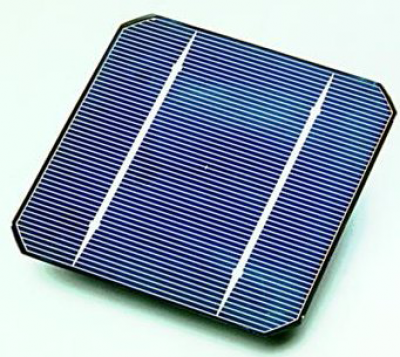
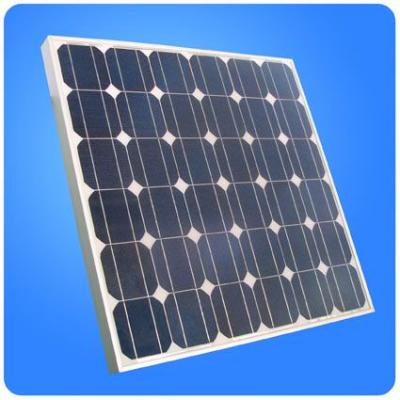
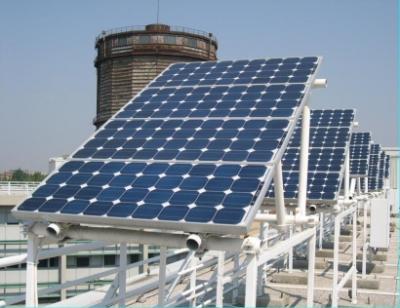
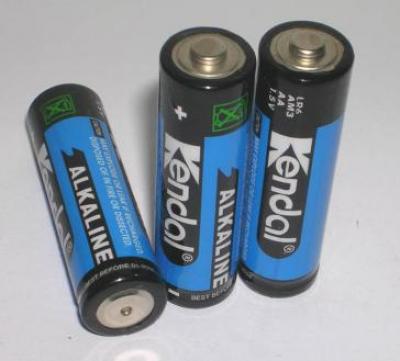
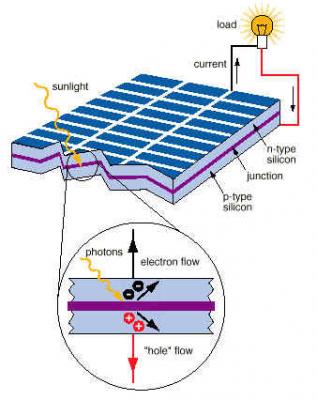
i was wondering if you make solar panels into a kind of liquid and which be alot strong so a lot more wieght could go on that say a car….
also thanks for telling me about the solar panel and it does seem the right way to go.
Jordan: To my knowledge no one has come up with a liquid solar cell yet, however there are organic dye solar cells that have liquid inside of various layers of glass and plastic.
Your very welcome! I hope you enjoy the site.
how frosiejor to made solar panel?wat cain silicon in apply to made panel?
I have a plain silicon wafer. It does not have the lines in it like seen on solar panels. What are the lines for? Are they etched or raised? Are they made of aluminum?
Would I be able to build a solar cell with it? It is a p-type. Would I need a n-type wafer to complete it.
It is a 8″ wafer. How many watts will this size produce(est).
Thanks for you site! Very informative.
so interesting how solar energy is achieved,however i was hoping making solar cells hence panels would be such an easy task provided that i have some profound understanding of electronics,however Boron and phosphorous doping to silicon becomes a stiff challenge in the entire process,and so is my question ,how is this doping done practically?Could some one reveal this to me ,and is there an alternative effective and cheaper way of producing the solar cell hence panels?
this site -very informative.
Magomere
MOMBASA,KENYA.
are cells one directional in collectinng sunlight to convert to energy? example…ithe cellt is applied to a white plastic base….can it collect sunlight from the back of it as well?
solar energy business….how its workout
I’m just looking too find a list of materials needed to make a simple 3.0 volt solar cell and maybe some instructions on how to build it. Like the size that you would find in a desk top calculator like 3/4 wide x 2 in. long x 3/16ths. of an in. thick size cell.